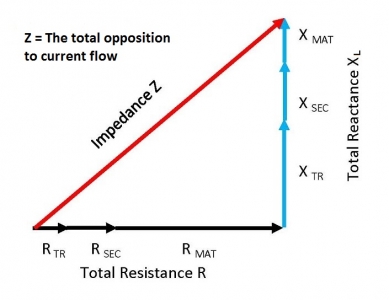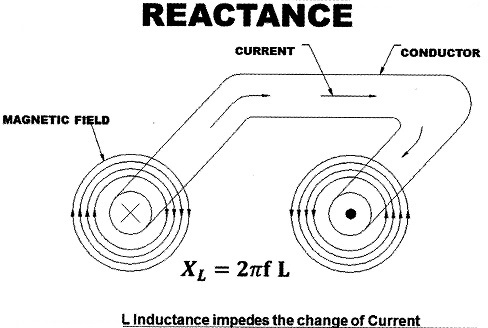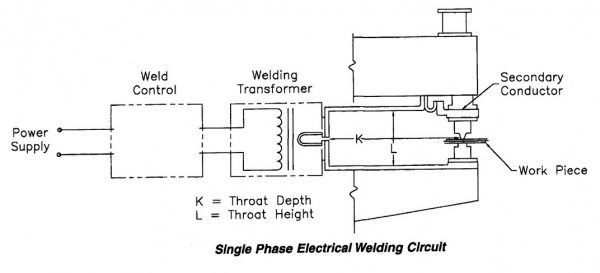
Controls & Transformers
Questions and Answers
Impedance (Z) is the total opposition to current flow. It is made up of the Resistance (R) and Reactance (X).

Reactance is created by the induced magnetic field around the conductors.

This induced field wants to stay in a steady state but in AC, current is constantly changing from positive to negative with the AC sine wave. The Reactance builds momentum in each half cycle and resists changing to the other direction. The stronger the magnetic field the larger the reactance (resistance). The size of the welder throat is a factor in determining this magnetic strength. Larger throat areas create stronger magnetic fields.
Ohm’s Law defines current as:
I= E/R
Where I is the current in Amperes, E is the potential in Volts and R is the resistance in Ohms.
In alternating current this formula becomes
I= E/Z
Where Z is impedance measured in Ohms.
(Z) Impedance has two components. They are R (resistance) and X (reactance).
The reactance of the secondary AC circuit is subject to changes in throat welder size and proximity of any magnetic materials. Therefore welder throat size is a factor in welder performance.

Larger throat sizes (K or L) increases the reactance and therefore the impedance increases. By Ohm’ Law the current will decrease with larger throat sizes.
The answer is two more coil turns in the primary of the transformer with the 47 vs the 45. This is not a lot of difference. Let’s discuss what turns ratio is. Turns ratio refers to the number of times the copper primary is coiled around the steel core in an AC transformer. For more information go to the article:
“WHAT IS TRANSFORMER TURNS RATIO?”
In it the following formula is given:

Vpri = Voltage on the primary Tpri = Turns in the primary coil
Vsec= Voltage on the secondary Tsec = Turns in the secondary coil
An AC secondary coil has one turn. So for easy math using 220 V input. The above formula results in:
The 47 turns would produce 4.7 V.
The 45 turns would produce 4.9 V
This is the voltage in the secondary circuit of the transformer. By changing the turns ratio we were able to change the voltage output of the transformer. Some transformers have tap switches built in. These tap leads connect to various points in the primary coil. This allows you to change the turns ratio of a transformer which gives you a multitude of voltages from one transformer.
See Article: WHAT IS THE LOWEST TRANSFORMER TAP?
Reference: RWMA Manual Chapter 19
The universal answer to this question is the number 1 tap. The deeper question is what does this represent? Transformers vary in design so the number 1 tap can also vary by design. What does not vary is that the lowest tap connects the primary to the maximum number of turns in the transformer. This will produce the lowest voltage available from the transformer. This low voltage will in turn drive lower currents and welding power. All other tap settings will produce more voltage and power being delivered to the resistance welder.
Page 19 of 39
Have a Question?
Do you have a question that is not covered in our knowledgebase? Do you have questions regarding the above article? Click here to ask the professor.
